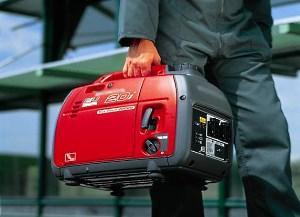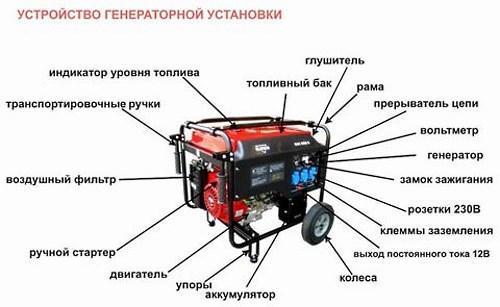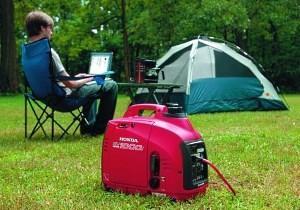Gasoline generator: which one is better to choose for a summer residence?
 Suburban life today attracts many, but once in the bosom of nature, newly-minted summer residents are faced with frequent power outages and or a complete lack of it. The same trouble is well known to new settlers who cannot do without connecting a construction power tool, as well as to travelers who want to make their vacation as comfortable as possible. The only way out is to equip your own autonomous power supply system. And here a gasoline generator for a home or a summer cottage can come to the rescue. It, being a permanent or emergency power source, will allow you to use all the necessary electrical appliances in any conditions.
Suburban life today attracts many, but once in the bosom of nature, newly-minted summer residents are faced with frequent power outages and or a complete lack of it. The same trouble is well known to new settlers who cannot do without connecting a construction power tool, as well as to travelers who want to make their vacation as comfortable as possible. The only way out is to equip your own autonomous power supply system. And here a gasoline generator for a home or a summer cottage can come to the rescue. It, being a permanent or emergency power source, will allow you to use all the necessary electrical appliances in any conditions.
Benefits of gasoline generators
Compared to diesel and gas appliances of this purpose, gasoline generators have a number of undeniable advantages:
- wide power range;
- easy start even at subzero temperatures;
- low cost of equipment;
- low noise level;
- low weight and dimensions of generators;
- operation without special training and knowledge.
As for the inconvenience, the owners of gasoline generators can only face the need to frequently add fuel and carry out preventive maintenance.
How to choose a gasoline generator?
When purchasing a generator, it should be remembered that this is a rather complex device that will have to be entrusted with practically the life support of the house. Therefore, before buying, it is important to pay attention to several parameters of the device:
- Generator power;
- Resource of work;
- Engine's type;
- Number of phases;
- Fuel consumption;
- Fuel tank volume;
- Startup type;
- Dimensions.

Rules for choosing a gasoline generator by power
 The power of a gasoline generator is the most important parameter when choosing a device. How to choose a gasoline generator and calculate the power of the device required for comfortable operation?
The power of a gasoline generator is the most important parameter when choosing a device. How to choose a gasoline generator and calculate the power of the device required for comfortable operation?
There are many models of generators that provide consumers with different power, ranging from portable, very compact models of 500 W, ending with powerful devices designed for 15 kW. You can find out the optimal value of this parameter by summing up the starting power of the consumers.
It is worth remembering that when starting electrical appliances with an inductive load, they consume much more than during stationary operation.
- Omic consumers. For such devices, the starting current is the same as the rated one. This class includes household incandescent lamps, kettles, electric stoves, irons, and soldering irons.
- Low inductance devices. Here, the starting current is one and a half or two times higher than the rated one. Such devices include household power tools, microwave ovens, video and computer equipment, fluorescent lamps.
- High inductance devices. The starting one is three or more times the rated load. This includes devices equipped with electric motors: compressors, well pumps, welding machines and transformers. In order to carry out welding work without problems, it is reasonable to purchase a special gasoline generator for welding with the ability to switch modes.

For a number of devices, increasing factors have been calculated to determine the starting power of the device.

In order not to complicate the calculation of power, you can start from the sum of the rated power of the devices available in the house, taking into account only 25 - 100% of the margin for starting loads.
Gasoline generator type
Along with conventional devices, modern inverter generators are offered to the consumer today. Such devices are equipped with built-in voltage stabilizers, they are compact, lightweight and economical, consuming at least 20% less fuel.
The design feature of the inverter gasoline generator allows you to reduce voltage surges in the network up to 2.5%. Which is extremely necessary when connecting any electronic equipment.
Despite the convenience of this type of generator, conventional models are more durable and easier to maintain.
Engine types
 Today, models of gasoline generators for home and summer cottages are produced, equipped with different types of engines:
Today, models of gasoline generators for home and summer cottages are produced, equipped with different types of engines:
- A two-stroke engine is installed on devices with a power of up to 2 kW. These are uncomplicated devices with small dimensions and weight. However, to operate such an engine, you will have to manually make a mixture of oil and gasoline.
- The four-stroke engine has its own lubrication mechanism. Here, fuel and oil are filled separately, which increases the reliability of the device. Such an engine is more resistant to loads and is efficient for much longer.
Also, gasoline generators can be synchronous and asynchronous:
- The asynchronous generator has a high protection class, is not sensitive to short circuits, high dust content in the air and the presence of moisture in it. Such devices are good on construction sites, and a gasoline generator for welding should be just that.
- The synchronous generator has a rather complex device. The principle of operation of the device is based on the formation of two magnetic fields rotating at the same speed. For such a gasoline generator, short-term overloads are not critical. Therefore, it can be used for backup power supply of complex household appliances, computer and electronic equipment.
Engine start type
The convenience of using the device and the speed of renewal of power supply depend on the type of starting the generator. Gasoline generators can be equipped with an electronic starter or a manual start device.
- Manual launch is structurally simpler. But it is convenient to use it only on condition that the generator is warm, that is, indoors or is operated in the summer.
- The electronic starter allows you to start the device without significant effort even at temperatures down to -20 degrees.
The purchase of a gasoline generator with auto start and its connection to the power supply system at home will allow you to comfortably use all household appliances when switching from one power source to another.

Sockets
It is convenient when the generator provides the ability to connect different types of consumers.
As a rule, sockets are installed:
- for single-phase 220 V current;
- for three-phase 380 V current;
- output to 12 B.
This ensures the convenient use of household appliances and professional equipment, as well as provide battery charging for construction appliances and other devices.
Installing the generator
There are no strict requirements for the installation site of a gasoline generator. However, it is worth adhering to the general safety requirements for the operation of such equipment:
- When installing the generator indoors, remember that ceilings cannot be lower than 2.5 meters.
- The generator and its working mechanisms must be freely accessible.
- The air temperature near the generator is also important. Most important to keep cool for air-cooled models.
- Overheating of the device can also occur due to prolonged exposure to direct sunlight.
- Gasoline generators for the home require a combustion product removal system and efficient ventilation.
- The equipment must be protected from moisture and dust.